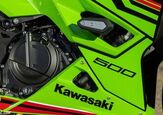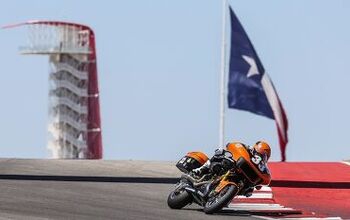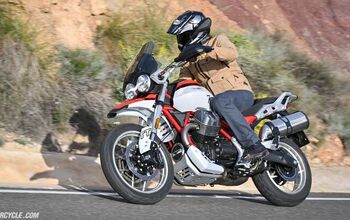
What kinds of riding do you do? Commuting? Touring? Canyon carving? If you're like most riders, the answer is all of the above. With the cost of new bikes these days, the luxury of having a different bike for each application is simply unaffordable. On the other hand, when manufacturers try to make one bike that is all things to everyone, something usually gets lost in the final execution. But fortunately, that doesn't stop them from trying.
We gathered up two of the most competent all-rounder motorcycles made today -- the Honda VFR750F and Suzuki's RF900R -- for a little head-to-head comparison: Which is the best at every type of street riding?
Despite the 150cc capacity difference, on paper these bikes look similar: Both have water-cooled 16-valve four cylinder motors with perimeter frames, fat 17 inch wheels and chain final drive. They both weigh about 450 pounds and hold 5.5 gallons of fuel. Even the prices are similar with the Honda undercutting the Suzuki by just 100 dollars. On the road though, differences become apparent.
Shifting the Honda's close-ratio six speed transmission is smooth and easy; it's probably the most refined tranny in the business. The Suzuki's long-legged five speed requires less shifting but has a short throw between gears requiring a more conscious effort on the lever for positive shifts.
A ride through the canyons reveals more differences. With the sportier riding position and the bigger motor, the Suzuki should have had the advantage when the going got going, but that just wasn't the case. The Honda rider was always able to run away and hide from the heavy-handling Suzuki -- despite the RF having more-adjustable suspension units. New for 1996, Suzuki added adjustable rebound damping control atop the 43mm cartridge-style forks to augment the spring preload adjusters, yet the action of the forks remains harsh. With the forks set up from the factory, the front end has a tendency to shimmy and shake its way over mid-corner bumps and pavement seams. Softening the preload and damping made for a smoother street ride, but didn't help its cornering attitude.
The sprightly VFR, though slightly under-sprung, gave excellent feedback through the front end and was much more confidence-inspiring when fully leaned over.
Turning the Honda from full tilt to back again takes less effort than the Suzuki, thanks to the profiles of its sticky Dunlop rubber. Four inches of trail may help explain the Suzuki's lazy steering manners.
Where the Suzuki looks to the GSXR1100 for ideas, the VFR needs look no further than the podium of just about any AMA National Superbike race in 1995 for inspiration. The 748cc 90 degree liquid-cooled V-4 is a relative once removed of the exotic and fast RC-45. Camshafts geared directly to the crankshaft. Four shim-under-bucket valves per cylinder. A slick-shifting close-ratio six speed gearbox. Narrow twin-spar frame made from lightweight and strong extruded aluminum. And the single-sided aluminum Pro-Arm swingarm straight off the experimental Elf 500cc Grand Prix bike.
Though not as powerful as those of the Suzuki, the Honda's Nissin twin-piston calipers grab their 296mm rotors with enough strength to stand the bike on its nose, yet they're progressive enough to trail-brake the red rocket right to the apex of your favorite corner. Scoops in the upper fairing direct cool air to the engine compartment where a bank of four 34mm flat-slide CV carbs feed fuel to the 70 x 48.6mm 748cc V-four. Tuned for low-end torque, throttle response and around town power are excellent, yet there is still a top-end hit when the tach reaches the high side of 7000 rpm. Vents in the rear side panel help disperse engine heat and a removable solo seat cowl is standard equipment. The r
When it came right down to deciding which bike was going to be declared best overall, we really had to look no further than the dash of the Honda. With everything else the VFR had in its favor, what gave Honda the nod was the digital clock right there above the tach.
Specifications
Honda VFR750FPrice: ,999Engine: dohc, 16-valve, V-FourBore x stroke: 70.0 X 48.6Displacement: 748ccCarburetion: (4)34mm KeihinTransmission: 6-speedWheelbase: 57.9 in.Seat height: 31.5 in.Fuel capacity: 5.5 gal.Claimed dry weight: 465.2 lbs.Suzuki 1996 RF900RTPrice: ,099Engine: dohc, 4-valve, inline-fourBore x stroke: 73mm x 56mmDisplacement: 937ccCarburetion: Four 36mm Mikuni BDSTTransmission: 5-speedWheelbase: 56.7 in.Seat height: 31.7 in.Fuel capacity: 5.5 gal.Claimed dry weight: 447 lbs

Motorcycle.com presents an unrivaled combination of bike reviews and news written by industry experts
More by Motorcycle.com Staff


































Comments
Join the conversation